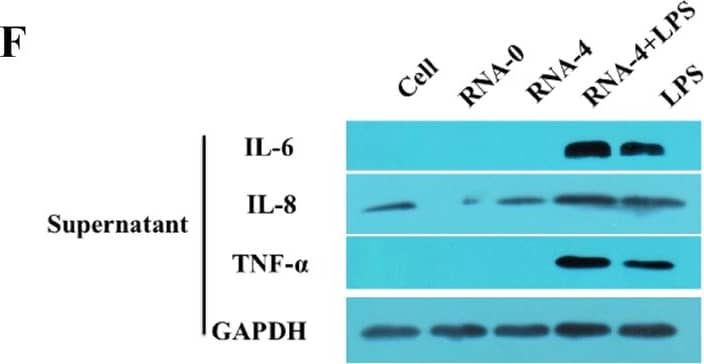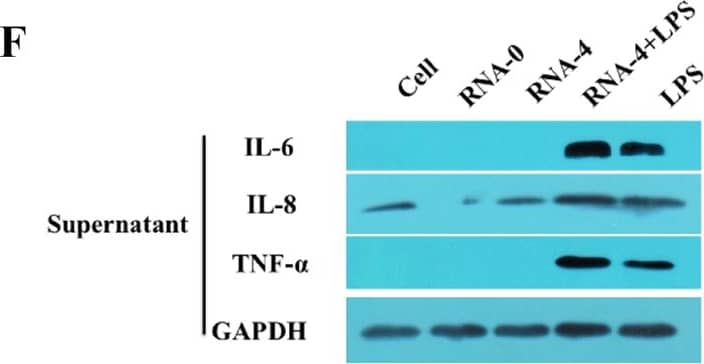Porcine TNF-alpha Antibody Summary
Arg78-Leu232
Accession # P23563
Applications
Please Note: Optimal dilutions should be determined by each laboratory for each application. General Protocols are available in the Technical Information section on our website.
Scientific Data
 View Larger
View Larger
Cytotoxicity Induced by TNF‑ alpha and Neutralization by Porcine TNF‑ alpha Antibody. Recombinant Porcine TNF-a (Catalog # 690-PT) induces cytotoxicity in the the PK-15 porcine kidney epithelial cell line in a dose-dependent manner (orange line), as measured by crystal violet staining. Cytotoxicity elicited by Recombinant Porcine TNF-a (0.05 ng/mL) is neutralized (green line) by increasing concentrations of Goat Anti-Porcine TNF-a Antigen Affinity-purified Polyclonal Antibody (Catalog # AF690). The ND50 is typically 0.2-0.8 µg/mL in the presence of the metabolic inhibitor actinomycin D (1 µg/mL).
 View Larger
View Larger
TNF‑ alpha in Porcine PBMCs. TNF-a was detected in immersion fixed porcine peripheral blood mononuclear cells (PBMCs) treated with calcium ionomycin and PMA using Goat Anti-Porcine TNF-a Antigen Affinity-purified Polyclonal Antibody (Catalog # AF690) at 15 µg/mL for 3 hours at room temperature. Cells were stained using the NorthernLights™ 557-conjugated Anti-Goat IgG Secondary Antibody (red; Catalog # NL001) and counterstained with DAPI (blue). Specific staining was localized to cytoplasm. View our protocol for Fluorescent ICC Staining of Non-adherent Cells.
 View Larger
View Larger
Detection of Porcine TNF-alpha by Western Blot Inflammatory response in PAMs induced by PRRSV 5′UTR RNA and LPS. A, B PAMs were transfected with different doses of 5′UTR RNA (1, 2, and 4 μg/well) along with 1 μg/mL LPS. qRT-PCR and Western blot results showed that compared with PAMs in other groups, PAMs in the 4 μg 5′UTR RNA and 1 μg/mL LPS co-stimulation group produced higher levels of IL-1 beta (p < 0.05). C After co-stimulation, the relative expression level of IL-1 beta mRNA obtained was similar at the 12 and 24 h time-points. D 5′UTR RNA and LPS co-stimulation induced IL-1 beta expression in cells and supernatants. E, F 5′UTR RNA and LPS co-stimulation induced increased levels of IL-6, IL-8 and TNF-alpha mRNA and protein. Expression was normalized to that of GAPDH. Different letters (a, b, c, d, and e) on data indicate significant differences between groups (p < 0.05). Image collected and cropped by CiteAb from the following open publication (https://pubmed.ncbi.nlm.nih.gov/31300043), licensed under a CC-BY license. Not internally tested by R&D Systems.
 View Larger
View Larger
Detection of Porcine TNF-alpha by Western Blot Inflammatory response in PAMs induced by PRRSV 5′UTR RNA and LPS. A, B PAMs were transfected with different doses of 5′UTR RNA (1, 2, and 4 μg/well) along with 1 μg/mL LPS. qRT-PCR and Western blot results showed that compared with PAMs in other groups, PAMs in the 4 μg 5′UTR RNA and 1 μg/mL LPS co-stimulation group produced higher levels of IL-1 beta (p < 0.05). C After co-stimulation, the relative expression level of IL-1 beta mRNA obtained was similar at the 12 and 24 h time-points. D 5′UTR RNA and LPS co-stimulation induced IL-1 beta expression in cells and supernatants. E, F 5′UTR RNA and LPS co-stimulation induced increased levels of IL-6, IL-8 and TNF-alpha mRNA and protein. Expression was normalized to that of GAPDH. Different letters (a, b, c, d, and e) on data indicate significant differences between groups (p < 0.05). Image collected and cropped by CiteAb from the following open publication (https://pubmed.ncbi.nlm.nih.gov/31300043), licensed under a CC-BY license. Not internally tested by R&D Systems.
Reconstitution Calculator
Preparation and Storage
- 12 months from date of receipt, -20 to -70 °C as supplied.
- 1 month, 2 to 8 °C under sterile conditions after reconstitution.
- 6 months, -20 to -70 °C under sterile conditions after reconstitution.
Background: TNF-alpha
Tumor necrosis factor alpha (TNF-alpha ), also known as cachectin and TNFSF2, is the prototypic ligand of the TNF superfamily. It is a pleiotropic molecule that plays a central role in inflammation, apoptosis, and immune system development. TNF-alpha is produced by a wide variety of immune and epithelial cell types (1, 2). Porcine TNF-alpha consisits of a 35 amino acid (aa) cytoplasmic domain, a 21 aa transmembrane segment, and a 176 aa extracellular domain (ECD) (3). Within the ECD, porcine TNF-alpha shares 69%‑86% aa sequence identity with bovine, canine, cotton rat, equine, feline, human, mouse, rat, and rhesus TNF-alpha. The 26 kDa type 2 transmembrane protein is assembled intracellularly to form a noncovalently linked homotrimer (4). Ligation of this complex induces reverse signaling that promotes lymphocyte costimulation but diminishes monocyte responsiveness (5). Cleavage of membrane bound TNF-alpha by TACE/ADAM17 releases a 55 kDa soluble trimeric form of TNF-alpha (6, 7). TNF-alpha trimers bind the ubiquitous TNF RI and the hematopoietic cell-restricted TNF RII, both of which are also expressed as homotrimers (1, 8). TNF-alpha regulates lymphoid tissue development through control of apoptosis (2). It also promotes inflammatory responses by inducing the activation of vascular endothelial cells and macrophages (2). TNF-alpha is a key cytokine in the development of several inflammatory disorders (9). It contributes to the development of type 2 diabetes through its effects on insulin resistance and fatty acid metabolism (10, 11).
- Idriss, H.T. and J.H. Naismith (2000) Microsc. Res. Tech. 50:184.
- Hehlgans, T. and K. Pfeffer (2005) Immunology 115:1.
- Pauli, U. et al. (1989) Gene 81:185.
- Tang, P. et al. (1996) Biochemistry 35:8216.
- Eissner G. et al. (2004) Cytokine Growth Factor Rev. 15:353.
- Black, R.A. et al. (1997) Nature 385:729.
- Moss, M.L. et al. (1997) Nature 385:733.
- Loetscher, H. et al. (1991) J. Biol. Chem. 266:18324.
- Clark, I.A. (2007) Cytokine Growth Factor Rev. 18:335.
- Romanatto, T. et al. (2007) Peptides 28:1050.
- Hector, J. et al. (2007) Horm. Metab. Res. 39:250.
Product Datasheets
Citations for Porcine TNF-alpha Antibody
R&D Systems personnel manually curate a database that contains references using R&D Systems products. The data collected includes not only links to publications in PubMed, but also provides information about sample types, species, and experimental conditions.
6
Citations: Showing 1 - 6
Filter your results:
Filter by:
-
Matrine inhibits IL-1? secretion in primary porcine alveolar macrophages through the MyD88/NF-κB pathway and NLRP3 inflammasome
Authors: P Sun, N Sun, W Yin, Y Sun, K Fan, J Guo, A Khan, Y He, H Li
Vet. Res., 2019-07-12;50(1):53.
-
Japanese Encephalitis Virus (JEV) NS1' Enhances the Viral Infection of Dendritic Cells (DCs) and Macrophages in Pig Tonsils
Authors: Xie S, Pan J, Zhang Q et al.
Microbiology spectrum
-
Atorvastatin treatment improves survival and effects of implanted mesenchymal stem cells in post-infarct swine hearts.
Authors: Yang YJ, Qian HY, Huang J, Geng YJ, Gao RL, Dou KF, Yang GS, Li JJ, Shen R, He ZX, Lu MJ, Zhao SH
Eur. Heart J., 2008-05-02;29(12):1578-90.
Species: Porcine
Sample Types: Tissue Homogenates
Applications: Western Blot -
Macrophage transcriptional responses following in vitro infection with a highly virulent African swine fever virus isolate.
Authors: Zhang F, Hopwood P, Abrams CC, Downing A, Murray F, Talbot R, Archibald A, Lowden S, Dixon LK
J. Virol., 2006-11-01;80(21):10514-21.
Species: Porcine
Sample Types: Cell Lysates
Applications: Western Blot -
Stent implantation in coronary porcine arteries is associated with early activation of TNFalpha and TNFalpha receptor II expression.
Authors: Hadjadj S, Cloutier I, Geoffroy P, Tanguay JF
Atherosclerosis, 2006-07-20;192(1):25-32.
Species: Porcine
Sample Types: Whole Tissue
Applications: IHC-P -
Liposomal delivery of heat shock protein 72 into renal tubular cells blocks nuclear factor-kappaB activation, tumor necrosis factor-alpha production, and subsequent ischemia-induced apoptosis.
Authors: Meldrum KK, Burnett AL, Meng X, Misseri R, Shaw MB, Gearhart JP, Meldrum DR
Circ. Res., 2003-02-21;92(3):293-9.
Species: Porcine
Sample Types: Whole Cells
Applications: Neutralization
FAQs
No product specific FAQs exist for this product, however you may
View all Antibody FAQsReviews for Porcine TNF-alpha Antibody
There are currently no reviews for this product. Be the first to review Porcine TNF-alpha Antibody and earn rewards!
Have you used Porcine TNF-alpha Antibody?
Submit a review and receive an Amazon gift card.
$25/€18/£15/$25CAN/¥75 Yuan/¥2500 Yen for a review with an image
$10/€7/£6/$10 CAD/¥70 Yuan/¥1110 Yen for a review without an image













